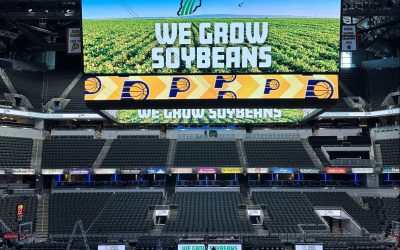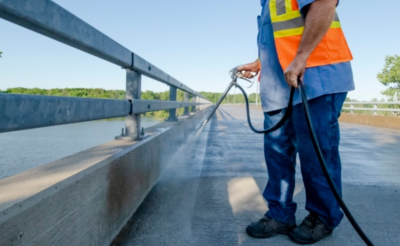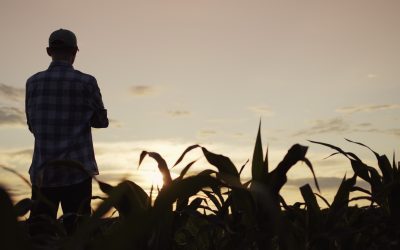Gary Lamie Scholarship winners pursue research in soil fertility and phenotyping
Despite the country coming to a rolling stop last year right before planting season, a certain two graduate students were still working hard, walking the fields and sifting through data for corn-production gold. Purdue graduate students Garrett Verhagen and Seth Tolley received the Indiana Corn Marketing Council’s (ICMC) Gary Lamie Scholarship in 2020. Named after former ICMC president Lamie, who died suddenly in 2013, the graduate student corn research assistantships are granted to students conducting research directly related to the Indiana corn industry.
Verhagen in particular was able to use the ICMC funds in an experiment to evaluate the impact of a sulfur application on plant health and nutrient removal in varying management situations. This was part of a larger experiment in evaluating yield and nutritional effects on varying hybrid varieties of corn, when supplemented with sulfur and other nutrients such as potassium.
“Why study sulfur and potassium?” Verhagen asked rhetorically during his results presentation. “Because sulfur deficiency symptoms have become increasingly common, and most Indiana research on the subject is outdated or inconclusive.”
Additionally, Verhagen said fertilizer prices are surging in 2021, and farmers wanting to maximize their yield at current corn prices need to know if such an application is worth it. Using no-till, strip-till, chisel-plow and moldboard plow management techniques, Verhagen set up 48 plots at two sites with varying hybrids to plot the effect of sulfur and potassium on the crops.
Though the research is ongoing, results from 2020 indicate that, though sulfur and potassium applications can increase nutrient removal, they do not have much of an effect on overall yield. Hybrid variability, he believes, played a large role in nutrient uptake and removal response to fertility application.
Phenotyping technology
Tolley, who received his Master’s degree in plant breeding and genetics at Purdue, used the scholarship to extend his PhD research working with phenotyping technology – specifically unmanned aerial vehicles (UAVs)—to collect plant data, and using ear photometry for phenotyping.
Between May and September of 2020, Tolley oversaw 19 UAV flights throughout the growing season and processed the data collected via software such as GRYFN, Phenix and Piz4D. The goal was to monitor in-season growth and development in the crops using reference measurements such as stand count, plant height, flowering date, grain yield and others. With ear photometry, Tolley assessed 25 yield components using kernels per ear, ear length and average kernel weight.
“We are evaluating the use of technologies such as ear photometry and unmanned aerial vehicles in understanding and predicting yield in corn,” Tolley explained. “The integration of these phenomics tools with genomics could help to improve future yields.”
Ag companies use this kind of technology – UAVs and ear photometers – to develop greater-yielding hybrids, and Tolley wanted to validate and demonstrate their utility. Validation of phenotyping tech has become extremely important to the corn industry, as companies and growers rely increasingly on the data collected using such techniques.
Passion for agronomy
Most toddlers do not simply wake up one day with an interest in agronomy that would grow and lead to higher education and career plans, but this might actually have been the case with Verhagen, who said his parents tell stories of him crawling and digging through dirt and plants at their home near Sammamish, Wash., before he could even walk.
“By the fourth grade, I decided to forego Pokémon cards and spend my birthday money on an AeroGarden hydroponic system,” Verhagen said. “I opted to grow the ‘Purple Super-Hot peppers’, much to my excitement and my parents’ concern.”
Throughout his grade school career, Verhagen retained his interest in plants, using science class time to conduct experiments, and even becoming the coordinator of a local community garden as a sophomore in high school. Needless to say, his undergraduate studies at Purdue were focused on plant breeding.
By 2017, Verhagen was working in Dr. Tony Vyn’s lab, exploring the vast extent of plant science and enjoying every long day of field work. Finding corn production to be his true passion, he became the research technician and lab manager for Vyn’s lab after graduating in 2018. A year later, Dr. Vyn gave him the opportunity to pursue a Master’s degree in corn research, which he accepted.
Originally from Avon, Ill., Tolley became interested in agriculture through his experiences growing up on a grain and cattle farm.
“I particularly liked the seasons of planting and harvesting on the farm,” he said. “When I was young, I enjoyed riding in the combine with my dad and helping out on the farm as I got older.”
Tolley’s parents and brother continue to grow crops and cattle in Illinois, and he said his experiences there have had a strong impact on his educational choices. But between his experiences with plants and cattle, his interest swayed more toward agronomy.
”I think plants are fascinating,” he said. “It is incredible to me that a single kernel of corn can produce an ear with over 600 kernels.”
Having essentially grown up in cornfields, Tolley decided crop sciences was the right undergraduate degree for him, and he proved himself correct, graduating from the University of Illinois in Champaign in 2017. Soon after, he rolled into the Hoosier state seeking a Master’s degree in plant breeding and genetics. He completed that in 2019, and is currently working on his PhD under Dr. Mitchell Tuinstra, whom he worked with during his phenotyping research.
Purdue provided opportunities
Both graduate students found attending Purdue gave them the opportunities they needed to gain more experience in agriculture and to pursue graduate degrees involving such intensive and relevant research. Both were thrilled with the opportunities their ICMC funding allowed them during a year adjusting to life in a pandemic-fraught world. It also helped them employ undergraduates to help with the research, including some who had lost their jobs due to the pandemic.
“The most satisfying aspect of my research is collaborating with other researchers at Purdue,” Tolley said.
Tolley plans to continue his PhD research at Purdue in plant breeding and genetics, and eventually wants to work in the industry.
“Growing up on the farm has had a great impact on me, especially in areas such as work ethic and respect for others. It has also given me a desire to pursue a career in an industry that can have an impact on farms like the one I grew up on.”
Verhagen said his ongoing research has reinforced his future goals of joining industry where he can use his research, technical and software-based knowledge to advance the best products to producers, while at the same time continuing to work with Dr. Vyn in publishing work in scientific journals.
“Through the support I have received from early-life mentors, graduate-study sponsors, and many more highly involved individuals, I have been able to gain the experience and knowledge required to fulfill my life purpose of pursuing the advancement of agricultural science,” Verhagen said.
Posted: April 21, 2021
Category: ICMC, Indiana Corn and Soybean Post - Spring 2021, News



